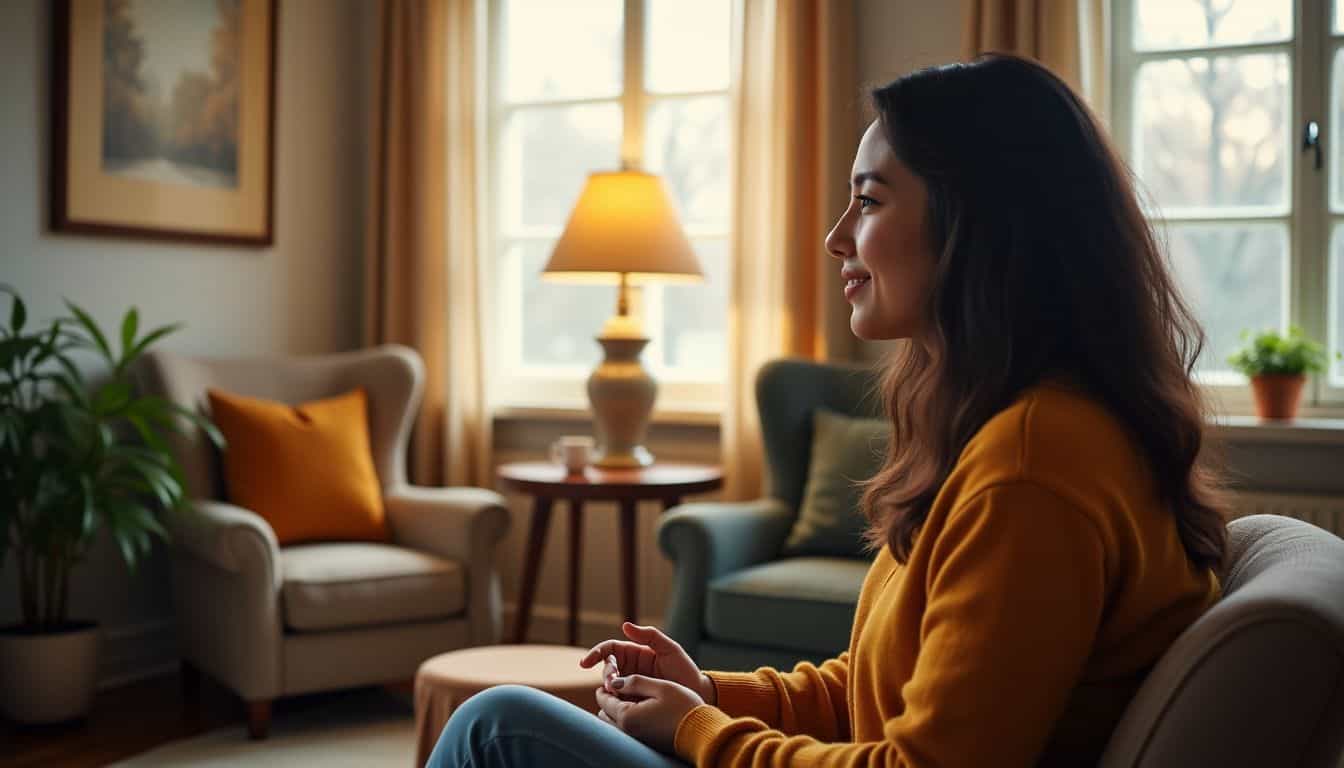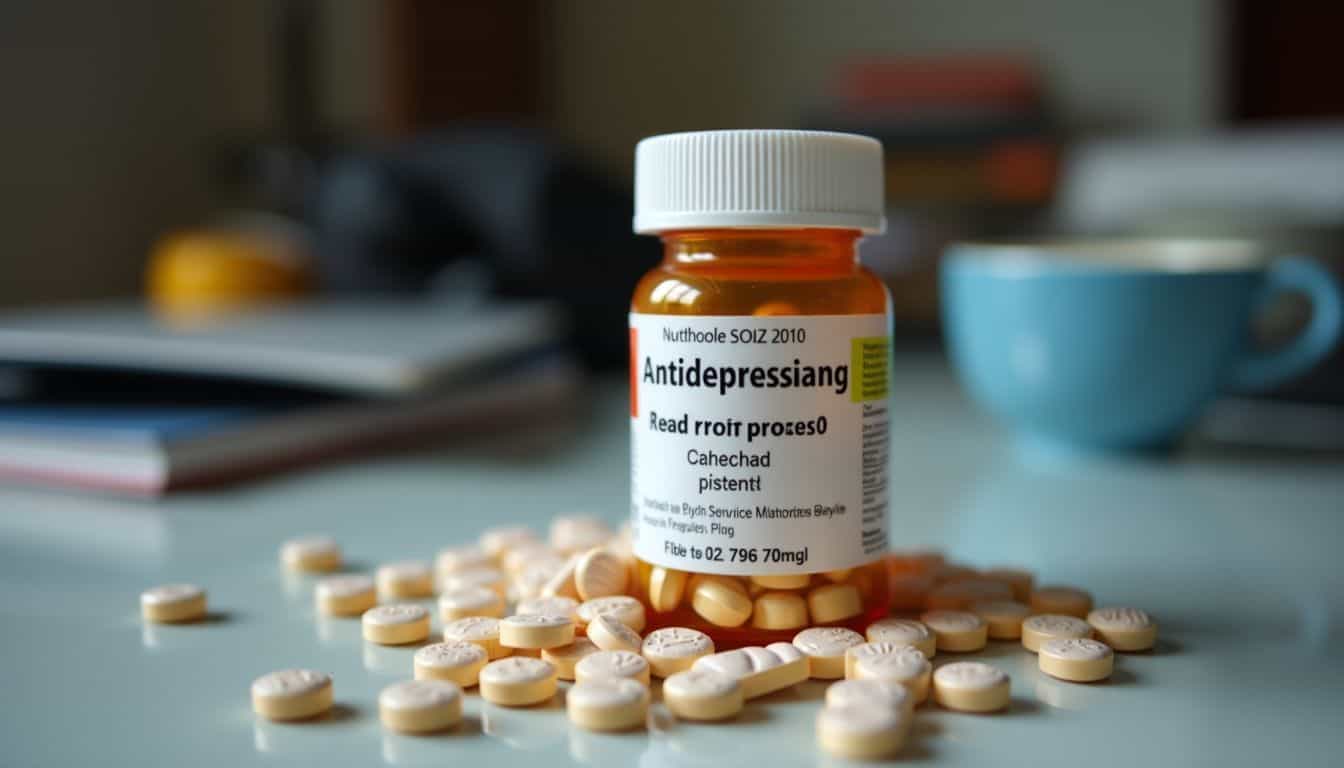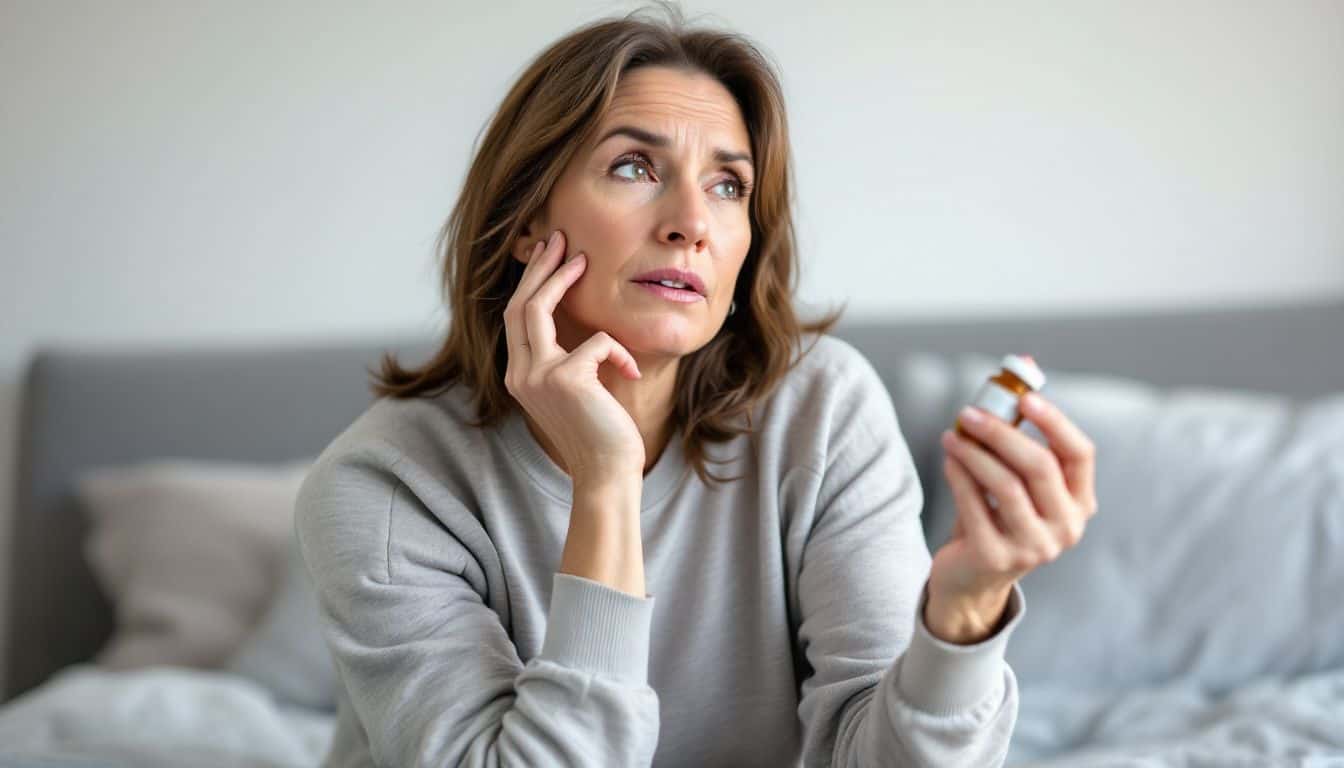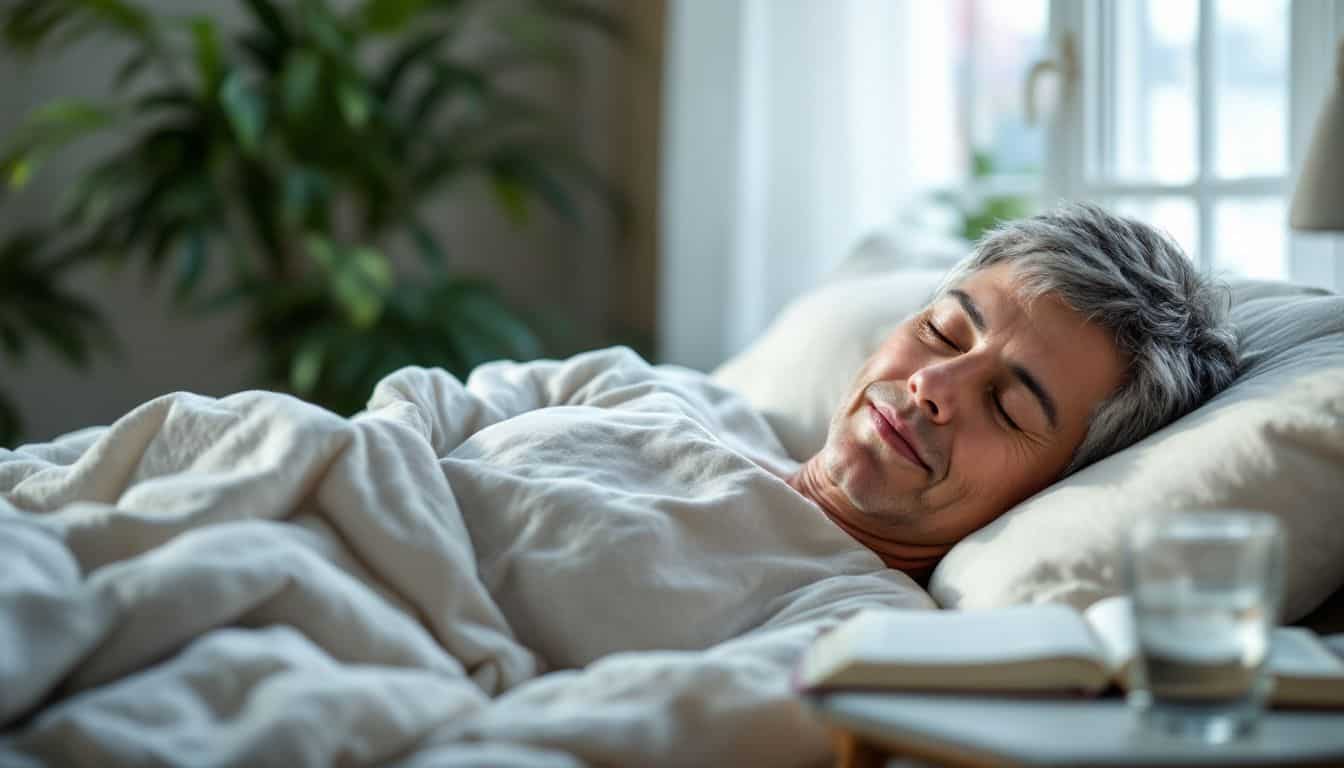Feeling down and struggling to find your way back to happiness can make each day feel heavy. Research shows that depression affects over 280 million people worldwide, making it one of the most common mental health issues today.
These science-backed depression treatment ideas can help you take small steps toward brighter days. Ready to explore proven ways to lift your mood and feel better?
Key Takeaways
Depression affects over 280 million people worldwide, with proven treatments including therapy, medication, exercise, and brain stimulation methods.
Research shows CBT helps treat depression in 45-60 minute sessions, while IPT focuses on improving relationships and social connections. Both work well for adults and teens.
Exercise fights depression through 30-minute sessions 3–5 times weekly, with activities like walking, swimming, and yoga showing strong mood-lifting benefits. Studies found 57.5% of Americans improved their health through yoga.
Brain stimulation treatments like ECT show an 80% success rate for severe depression cases, while rTMS offers a gentler option, with sessions lasting 3.5 to 37 minutes.
Natural treatments like St. John’s wort and saffron can help mild depression, while lifestyle changes like better sleep habits and limiting alcohol use create lasting improvements. Studies show 75.8% of people with poor sleep habits experience depression.
Table of Contents
Psychotherapy

Psychotherapy helps many people deal with depression through regular talks with trained mental health professionals. You’ll learn new ways to handle tough feelings and change negative thought patterns during these sessions.
Cognitive Behavioral Therapy (CBT)

Cognitive Behavioral Therapy stands as a proven method for depression treatment. Research from 115 studies shows CBT helps people overcome major depressive disorder.
Each therapy session lasts 45 to 60 minutes. Mental health professionals use CBT to teach patients how to spot negative thought patterns. The therapy works well for mild to moderate depression cases.
People learn to replace harmful thoughts with more balanced ones during these sessions.
CBT targets specific thinking errors that fuel depression symptoms. The therapy helps break down black-and-white thinking and overgeneralization habits. Patients gain tools to challenge their negative beliefs about themselves and situations.
Medical experts often suggest CBT before trying antidepressants for mild cases. Some people with severe depression might need medicine first. The therapy creates lasting changes by fixing unhelpful thought patterns that cause low moods.
Interpersonal Therapy (IPT)

While CBT focuses on changing thought patterns, Interpersonal Therapy takes a different path. IPT targets your relationships and social connections to lift your mood. This therapy zeros in on four main areas: dealing with grief, solving role conflicts, adapting to life changes, and building better social skills.
Studies show IPT works great for both adults and teens who struggle with depression.
IPT helps teens handle their emotions better through special sessions called IPT-A. Research proves that teens in IPT-A feel much better compared to those who only get regular check-ups.
Parents play a big part in this process, especially for young people who need help with social skills. The success of IPT depends on two key things: a strong bond with your therapist and your active effort in the process.
Many women find IPT helpful because it deals with real-life situations and current relationships rather than past issues.
Medication

Medication plays a vital role in treating depression by fixing brain chemistry and easing symptoms. Your doctor might suggest antidepressants alone or mix them with other treatments to help you feel better faster.
Antidepressants

Antidepressants serve as powerful tools in treating depression, offering hope to many women who find themselves crying in bed.
These medications target brain chemicals linked to mood and emotions, helping restore balance in daily life. Most selective serotonin reuptake inhibitors (SSRIs) and other types of antidepressants need four to eight weeks to show their full effects.
Patience with treatment leads to better outcomes – Dr. Sarah Thompson, Mental Health Expert
Your doctor might suggest trying different doses or combining medications to find the right fit for you. More than 20 antidepressant options exist as first-line treatments for clinical depression.
Many women notice positive changes in their sleep patterns, energy levels, and overall mood once they find the right medication match.
Combination Therapy
Combination therapy mixes talk therapy and medicine to fight depression better. Major mental health groups back this approach for moderate to severe depression cases. Studies show patients get better faster with both treatments working together.
I’ve seen many clients achieve lasting results through this method in my practice.
Mental health pros work as a team to give you the best care possible. Your therapist and doctor stay in touch about your progress. The mix often includes CBT or mindfulness work plus medication.
This team approach helps many women stick to their treatment plan. Most patients feel more supported with two experts guiding their care. The mix of treatments boosts your chances of feeling better long-term.
Exercise

Exercise stands as a powerful tool against depression, with studies showing it boosts mood-lifting chemicals in your brain. A brisk walk, dance class, or swim can lift your spirits within minutes – and these natural mood boosters work even better when you make them part of your daily routine.
Aerobic Activities
Aerobic activities stand as a proven way to fight depression. Research shows that regular movement can lift your mood and boost your mental health.
- Moving your body for 30 minutes, 3–5 times weekly, helps beat the blues. The World Health Organization backs this as a key treatment for depression.
- Walking remains the easiest way to start. A brisk 20-minute walk around your neighborhood can spark positive changes in your brain.
- Swimming offers a full-body workout that’s gentle on your joints. The rhythmic movements in water create a natural meditation effect.
- Dancing brings joy while burning calories. Put on your favorite music and move freely for 15–20 minutes daily.
- Cycling outdoors or on a stationary bike works great for all fitness levels. Start with 10 minutes and build up to 30-minute sessions.
- Low-impact aerobics classes feel less scary than high-intensity workouts. These classes help you stick to your routine better.
- Jogging at your own pace builds strength and confidence. Start with a mix of walking and light jogging for 15 minutes.
- Mall walking provides a safe, climate-controlled space for movement. Many malls open early for walkers to exercise freely.
- Jumping rope burns lots of calories in short bursts. Try 1-minute intervals with rest breaks between.
- Step aerobics builds leg strength while lifting mood. Start with a low step and simple moves.
- Moderate-intensity activities show the same benefits as harder workouts. You’ll feel better without pushing too hard.
Yoga and Mindful Movement
Yoga offers a powerful way to fight depression through mindful movement and breathing. Research shows 57.5% of Americans have found better health through yoga practice.
- Daily yoga practice calms your mind and reduces stress in just 10 minutes. Your body releases feel-good chemicals during gentle stretches and poses.
- Simple sun salutations boost your mood by connecting breath with movement. These flowing poses wake up your body and clear mental fog.
- Gentle twists and forward bends massage your internal organs and ease tension. Your muscles relax as you hold each pose for 5-8 breaths.
- Deep breathing exercises during yoga poses help regulate emotions. The ventromedial prefrontal cortex becomes more active during mindful breathing.
- Child’s pose and legs-up-the-wall reduce anxiety symptoms naturally. These restful positions lower stress hormones in your body.
- Yoga nidra (yogic sleep) improves sleep quality through guided relaxation. Many people report better rest after 20 minutes of practice.
- Partner yoga builds social connections while moving mindfully. Shared movement creates trust and emotional support.
- Restorative yoga poses reduce inflammation linked to depression. Props like blankets and blocks support deep relaxation.
- Chair yoga makes mind-body practice accessible for all fitness levels. Simple seated stretches release physical and mental tension.
- Outdoor yoga combines nature’s healing power with mindful movement. Fresh air and natural light boost mood during practice.
- Music-based yoga flow creates joy through rhythm and movement. Upbeat songs lift spirits while moving through poses.
Brain Stimulation Therapies

Brain stimulation therapies offer new hope for people who haven’t found success with standard depression treatments. Medical experts now use gentle electrical currents or magnetic fields to target specific brain areas that control mood and behavior.
Electroconvulsive Therapy (ECT)
Electroconvulsive therapy stands as a powerful treatment option for severe depression and bipolar disorder. Medical experts use ECT to help patients who haven’t responded well to other treatments.
The process involves brief electrical pulses to specific brain areas while the patient sleeps under anesthesia. Studies show an impressive 80% success rate among patients who try this treatment.
Most people need about six to twelve sessions, spread across two to three visits per week.
ECT gave me my life back after years of struggling with treatment-resistant depression. – Sarah M., ECT patient
ECT offers quick relief from major depression symptoms compared to many other treatments. Doctors must get informed consent and do a full mental health check before starting ECT. Some patients might notice short-term memory issues after treatment.
The medical team watches closely for any problems related to anesthesia during the procedure. Modern ECT techniques have made this treatment much safer and more precise than older versions.
Many patients feel better within weeks of starting their sessions.
Repetitive Transcranial Magnetic Stimulation (rTMS)
Unlike ECT, repetitive Transcranial Magnetic Stimulation offers a gentler approach to brain stimulation therapy. The FDA supports rTMS as a treatment choice for major depression after other options fail.
This modern therapy sends magnetic pulses straight to the brain areas that control mood. Patients stay awake during the quick sessions, which take between 3.5 to 37 minutes.
The treatment happens in regular doctor’s offices without any need for sleep medicine. Most people notice only mild side effects like headaches or slight scalp discomfort. Some might feel their face muscles twitch during treatment.
Results from rTMS build up slowly over several weeks of regular sessions. Many patients see good results without the memory issues that sometimes come with other brain treatments.
Lifestyle Changes

Small changes in your daily habits can make a big impact on your mental health. Good sleep and staying away from alcohol will help your brain heal and give you more energy to face each day.
Improving Sleep Hygiene
Poor sleep habits can make depression worse. Studies show that 75.8% of people with bad sleep habits feel depressed, compared to 59.6% of those with good habits.
- Create a fixed bedtime routine to help your brain know it’s time to rest. More than half of people struggle with poor sleep habits, but a steady routine can cut this number down.
- Keep your bedroom dark, quiet, and cool at night. Studies link these changes to better sleep quality, which helps fight depression and anxiety.
- Put away phones and tablets an hour before bed. The blue light from screens messes with your sleep cycle and makes you feel more tired the next day.
- Skip caffeine after 2 PM. People who drink coffee late in the day are 22.5% more likely to feel sleepy during daytime hours.
- Exercise during the day, but not right before bed. Regular physical activity helps you fall asleep faster and sleep deeper.
- Use your bed only for sleep and intimacy. This trains your brain to link your bed with rest, not work or entertainment.
- Get up at the same time every day, even on weekends. This helps set your body’s natural sleep clock and improves your mood.
- Take a warm bath or shower before bed. This natural way to relax your muscles can help you drift off faster.
- Keep a sleep diary to track what helps you rest better. Writing down your sleep patterns lets you spot what works and what doesn’t.
- Deal with worries before bedtime. People who practice relaxation techniques report better sleep quality and less depression.
Limiting Alcohol and Substance Use
Alcohol and drugs can make depression worse for many women. Living with an abusive drunk husband or partner often leads to deeper mental health issues.
- Quit drinking alcohol during depression treatment. Your medication works better without alcohol in your system. Many women notice their mood lifts after staying sober for just two weeks.
- Track your triggers that make you want to drink. Keep a small notebook to write down times, places, and feelings that spark cravings. This helps you spot patterns and avoid risky situations.
- Join a women’s sobriety support group. Meeting others who face similar struggles creates strong bonds. These groups offer tips and friendship to beat isolation.
- Replace alcohol with healthy drinks. Sparkling water with fruit, herbal teas, or smoothies give you something nice to sip. Your body will thank you for choosing better options.
- Learn new ways to handle stress. Take a walk, call a friend, or try deep breathing instead of drinking. Your mental health improves with better coping skills.
- Clear your home of alcohol and drugs. Ask family to help remove temptations. A clean space supports your recovery goals.
- Tell friends about your choice to stay sober. True friends will respect your decision and help you stick to it. Some may join you in living alcohol-free.
- Get professional help if needed. Doctors and counselors know how to treat both depression and substance use. They create plans that work for your specific needs.
- Focus on sleep and exercise. Your mood gets better with good rest and movement. Both help fight cravings and boost your energy.
- Start new alcohol-free hobbies. Paint, garden, or learn to cook. Fun activities fill time you used to spend drinking.
Natural and Alternative Treatments

Many people find relief from depression through natural remedies like herbs and supplements that work with the body’s chemistry. Research shows that some alternative treatments can help ease symptoms without the side effects of standard medications.
Herbal Supplements
Natural herbs offer hope for people with depression. St. John’s wort stands out as a popular choice for mild depression symptoms. Studies show it can help lift mood in the short term.
Yet, this herb might clash with other medications you take. Saffron proves just as strong as some prescription antidepressants in fighting depression. The bright red spice brings real results in clinical trials.
The FDA doesn’t check dietary supplements like they do with regular medicine. This lack of control means supplement quality varies a lot. Ginseng shows promise in lab studies, mostly with animals.
People who drink chamomile tea report less anxiety and fewer depression symptoms. Still, scientists need to study these herbs more. I tried several herbal supplements myself and found chamomile tea especially calming before bedtime.
Acupuncture
Acupuncture offers real help for women dealing with depression. This ancient practice boosts key brain chemicals like serotonin and norepinephrine that affect mood. Studies show it helps reduce body inflammation linked to depressive symptoms.
Many women find relief through tiny needles placed at specific points on their body.
Licensed acupuncturists use traditional Chinese medical wisdom to support emotional healing. The treatment improves brain function and promotes mental wellness in a gentle way. Your mental health professional can tell if this option fits your needs.
Most women notice positive changes after several sessions, though results vary by person. The process works best as part of a complete treatment plan for major depressive disorder.
Social Support

Strong social bonds can lift your mood and ease depression symptoms. Friends and family create a safe space where you can share your feelings and get the emotional support you need.
Spending Time With Loved Ones
Family time plays a vital role in fighting depression, especially for teens. Research shows that teens who spend more time with parents report fewer depressive symptoms over time. The simple act of sharing meals, taking walks, or playing games with family members can lift your mood.
Parents who make time for their kids create a strong support system that helps prevent mental illness.
Quality time with loved ones builds emotional connections and reduces feelings of sadness. Studies prove that increased parental interaction leads to better mental health outcomes in adolescents with major depressive disorder.
Family routines matter – they create stability and comfort during tough times. Support groups offer another way to connect with others facing similar challenges….
[Next section: Joining Support Groups]
Joining Support Groups
Support groups create a safe space to share your feelings with others who face similar mental health challenges. Groups like Mental Health America and NAMI offer both online and in-person meetings led by licensed mental health professionals.
These gatherings help many women reduce or stop their antidepressant use through mutual support and understanding.
Social connections in support groups make a real difference in fighting depression symptoms. Research shows strong group bonds improve mood disorders and ease feelings of isolation.
Many women find comfort in talking openly about their experiences with others who truly get it. Local DBSA and ADAA chapters provide free resources to connect you with nearby support groups that match your needs.
Expressive Therapies

Creative arts offer a powerful way to express deep feelings without words. Art and music can help people with depression share their emotions in a safe space with trained therapists.
Art Therapy
Art therapy offers a powerful way to express feelings without words. Many women find comfort in painting, drawing, and other art forms to ease their depression symptoms. Studies show this treatment works well for both depression and anxiety issues.
Through art, you can share emotions that feel hard to say out loud. The process builds self-esteem and helps you bounce back from tough times.
Your mental health professional guides you to use colors, shapes, and different art supplies to show what’s inside. This safe space lets you explore deep feelings and grow stronger.
Art therapy makes real changes in how you feel and think. Many patients report better moods and less stress after regular sessions. The healing power of art opens new paths to mental wellness.
Moving forward, music therapy brings another creative approach to treating depression….
Music Therapy
Music therapy offers a powerful way to lift your mood through songs and sounds. A trained music therapist leads each session, helping you explore different musical activities like singing or playing instruments.
You don’t need any musical skills to benefit from this treatment. Many women find comfort in discussing song lyrics or creating simple tunes during their sessions.
I tried music therapy last year and discovered its amazing effects on mental health. The sessions helped me relax and manage my anxiety better. Music therapy works well for people with depression, anxiety disorders, and other mental health concerns.
The best part? You can express your feelings without saying a word – just through music. Your therapist will create a personal plan that fits your needs and comfort level.
Mindfulness and Relaxation

Mindfulness and relaxation can ease your mind during tough mental health battles. These simple yet powerful practices help you focus on the present moment and bring peace to your daily life.
Meditation Practices
Meditation helps many women find peace in their daily lives. Studies show it works well for stress, anxiety, depression, and sleep troubles.
- Start with a body scan meditation by lying down in a quiet room. Focus on each part of your body from toes to head, noting any tension or discomfort.
- Sit in a comfy spot for 10–15 minutes of breathing focus. Count each breath slowly to keep your mind from wandering to daily worries.
- Try walking meditation in nature or a peaceful space. Pay attention to each step and the way your feet touch the ground.
- Set up a daily meditation time, like early morning or before bed. Clinical trials show six months of regular practice creates lasting habits.
- Use guided meditations from apps or videos if you’re new to the practice. These tools help you stay on track with expert voice guidance.
- Pick a quiet spot away from noise and distractions. Your bedroom or a peaceful corner works great for better focus.
- Keep your meditation simple at first – just 5–10 minutes daily. Research shows even short sessions help reduce stress and improve attention.
- Notice physical signs of stress during meditation. Tight shoulders or racing thoughts tell you where to focus your attention.
- Practice self-kindness if your mind wanders. Gentle attention brings your focus back to your breath or body sensations.
- Mix different types of meditation to find what suits you best. Some women prefer movement-based practice, while others like sitting still.
Deep Breathing Exercises
Deep breathing exercises offer a natural way to calm your mind and reduce stress levels. These simple yet powerful techniques help women manage anxiety and create a sense of peace during busy days.
- Take slow breaths through your nose for 4 counts, hold for 2 counts, then release through your mouth for 6 counts. This basic pattern forms the foundation of stress relief.
- Find a quiet spot in your home or office to practice breathing exercises for 5–10 minutes daily. Your body and mind need this dedicated time to reset.
- Focus on your belly rising and falling with each breath. Place one hand on your stomach to feel this gentle movement.
- Practice box breathing by drawing an imaginary square – inhale for 4 counts, hold for 4, exhale for 4, hold for 4. This technique helps reduce anxiety symptoms.
- Try the 4-7-8 breathing method before bed to improve sleep quality. Inhale for 4 counts, hold for 7, exhale for 8.
- Use deep breathing during stressful moments like work presentations or difficult conversations. This helps maintain emotional balance.
- Set breathing reminders on your phone to practice throughout the day. Regular practice makes the technique more effective.
- Combine deep breaths with positive self-talk or affirmations. This creates a powerful mindfulness practice.
- Start your morning with 5 minutes of mindful breathing to set a calm tone for the day. Morning practices build healthy habits.
- Practice guided breathing using free meditation apps or videos. These tools provide helpful structure for beginners.
People Also Ask
What are the main types of depression that people face?
Common types include major depressive disorder, persistent depressive disorder, bipolar disorder, and seasonal affective disorder. Some women may also face premenstrual dysphoric disorder or perinatal depression.
How can I tell if I need help for depression?
Look for signs like mood swings, restlessness, decreased libido, and ongoing sadness. If you have thoughts of suicide or symptoms of psychosis like delusions or hallucinations, see a mental health professional right away.
What therapy options work best for depression?
Talk therapy, especially cognitive behavioral therapy, helps many people. Other choices include electroconvulsive therapy (ECT), brain stimulation therapies, and different types of psychotherapy. Your doctor can help pick the right one.
Can natural remedies help with depression?
Some people find relief with integrative medicine and supplements like St. John’s Wort. But always talk to your doctor first, as these can affect other medicines and may cause physical dependence.
How is depression different in teenagers?
Teens may show more anger, attention problems, and mood dysregulation. They might also have social phobia or panic disorder along with depression. Treatment needs to change based on age and symptoms.
What should I know about depression medicines?
Common options include serotonin-norepinephrine reuptake inhibitors and tricyclics. Medicines like Effexor XR and Forfivo XL can help, but they need careful watching by a doctor to avoid addiction or drug interactions.
References
https://pmc.ncbi.nlm.nih.gov/articles/PMC7001356/
https://pmc.ncbi.nlm.nih.gov/articles/PMC5915317/
https://pmc.ncbi.nlm.nih.gov/articles/PMC6519650/
https://pmc.ncbi.nlm.nih.gov/articles/PMC8602192/
https://www.bmj.com/content/384/bmj-2023-075847
https://pmc.ncbi.nlm.nih.gov/articles/PMC3293477/
https://www.psychiatry.org/patients-families/ect
https://www.mayoclinic.org/tests-procedures/transcranial-magnetic-stimulation/about/pac-20384625
https://pmc.ncbi.nlm.nih.gov/articles/PMC10105495/
https://www.healthline.com/health/depression/how-to-fight-depression
https://www.medicalnewstoday.com/articles/314421
https://pmc.ncbi.nlm.nih.gov/articles/PMC10838506/
https://pmc.ncbi.nlm.nih.gov/articles/PMC6620148/
https://pmc.ncbi.nlm.nih.gov/articles/PMC3271042/
https://www.psychiatry.org/news-room/apa-blogs/social-groups-to-help-manage-depression
https://pmc.ncbi.nlm.nih.gov/articles/PMC8397377/
https://my.clevelandclinic.org/health/treatments/8817-music-therapy
